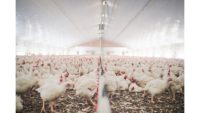When it comes to reducing Salmonella prevalence at processing, U.S. Department of Agriculture (USDA) data show the industry is making progress. We still have a long way to go, however, and with public interest in food safety on the rise, the pressure is on everyone across the chain to make improvements.
Salmonella levels might be measured at the processing plant, but Salmonella originates in live production. Young chicks become easily colonized because their immune systems aren’t fully developed, and in many cases our production practices, such as reusing litter, favor Salmonella exposure if they’re not managed carefully. Meanwhile, infected hens can vertically transmit Salmonella to broilers, while eggshells contaminated with feces, unsanitized egg rooms or contaminated transport equipment can also be sources of infection.
Eliminating positive flocks might sound like the obvious solution, but it’s not a realistic option. Instead, vaccinating breeding hens, discarding dirty eggs and properly sanitizing storage facilities, air handling units, egg flats and transport vehicles should all be standard practices.
Preventing Salmonella in broilers
Most producers vaccinate breeders against Salmonella. Vaccinating broilers against the pathogen is important. Trials have shown significant success in reducing positive carcasses and parts. In one trial involving 8.5 million broilers raised without antibiotics (4 million vaccines), there was about a 30 percent reduction in positive carcasses and 40 percent reduction in parts positive for Salmonella.
Proper ventilation, reducing litter moisture, progressively acidifying water the final 72 hours before processing and withdrawing feed eight hours before processing can all help keep Salmonella numbers down.
Last chance: processing
Processing is the last chance to contain or eliminate Salmonella on carcasses. There should be a pre-scald carcass brush wash, and using acidic sanitizers on picker rails helps.
Scalders can also be an intervention. If you use an acid sanitizer, you can decrease the scalder temperature to maintain skin integrity, which reduces bacterial attachment and improves picking. The scalder temperature, however, shouldn’t go below 123°F (50.5°C), in which case Salmonella will grow.
Evisceration must ensure sanitary dressing, which might require reducing line speed, adjusting equipment or making staff changes to prevent digestive-tract spillage.
Producers have several options for chilling, including peroxyacetic acid (PAA), hypochlorus acid, which is chlorine, and buffered sulfuric acid. Organic and inorganic acids are also possibilities.
Post-chill, antimicrobial and/or acidified immersion baths should be used. Processing belts should be treated continuously with an antimicrobial such as chlorine, a stabilized acid or PAA.
When proper processing procedures are coupled with live-side efforts, they can go a long way toward reducing Salmonella on chicken carcasses.
Communication is essential
I recommend that live production managers attend Food Safety and Inspection Service (FSIS) meetings at least monthly and review condemned carcasses along with processing plant management.
Live production managers, as well as service technicians and processing plant managers, should collaborate on feed withdrawal to find what works best to prevent litter picking while reducing intestinal contents.
Undoubtedly, a properly executed Salmonella prevention and control plan requires a lot of hard work and resources, but it’s not optional — it’s the cost of doing business. NP









